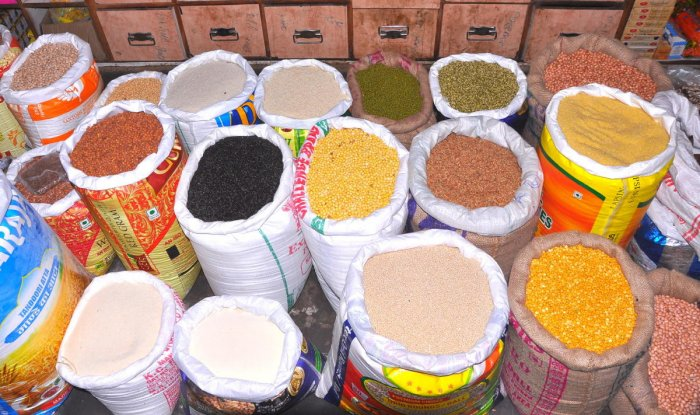
Copyright infringement not intended
Context: According to UN COMTRADE statistics, India's foodgrain exports have increased steadily in recent years, increasing India's share in global foodgrain exports from 3.38% in 2010 to 7.79% in 2022.
Details
- India is one of the major players in the global food grains market, and its exports of agricultural products, including food grains, have been steadily increasing over the years. According to UN COMTRADE statistics, India's share in the world food grains market based on exported values was 7.79% in 2022, showing significant growth from 3.38% in 2010.
- Top 10 agriculture products exported from India based on their values in USD Million.
-
- Marine Products
- Rice (Other Than Basmati)
- Sugar
- Rice (Basmati)
- Spices
- Buffalo Meat
- Oil Meals
- Wheat
- Miscellaneous Processed Items
- Castor Oil
- Top 10 importers of India's agriculture products based on their values in USD Million.
-
- USA
- China
- Bangladesh
- United Arab Emirates (UAE)
- Vietnam
- Saudi Arabia
- Indonesia
- Malaysia
- Iran
- Thailand
Growth has been driven by several factors including;
Expanding Markets
- Both domestic and international markets for Indian foodgrains have witnessed growth. Rising demand, driven by a growing population and changing dietary preferences, has contributed to the expansion of domestic markets.
- On the global front, India has been able to tap into new markets due to competitive prices and adherence to quality standards, making its food grains more attractive to international buyers.
Supportive Government Policies
- The Government of India has implemented various policies and initiatives to support the foodgrain sector. The Minimum Support Price (MSP) scheme ensures that farmers receive remunerative prices for their crops, encouraging increased production.
- The Public Distribution System (PDS) ensures food security for vulnerable populations by distributing subsidized food grains. The Food Corporation of India (FCI) plays a crucial role in procuring, storing, and distributing food grains.
- The Agricultural and Processed Food Products Export Development Authority (APEDA) facilitates agricultural exports, including food grains. The Pradhan Mantri Kisan Samman Nidhi (PM-KISAN) scheme provides direct income support to farmers, further bolstering their income and agricultural activities.
Resilience to Challenges
- The Indian foodgrain sector has displayed resilience in coping with various challenges, including climate change, natural disasters, pests, and diseases. Innovative farming techniques and risk management strategies have enabled the sector to mitigate the adverse effects of such challenges.
Overall, the combination of increased production, expanding markets, supportive government policies, and the sector's resilience has contributed to the steady growth of India's foodgrain exports. These factors have positioned India as a significant player in the global foodgrain market, contributing to both the country's economic growth and global food security.
Significance
Enhancing Farmer Income and Rural Welfare
- Increased food grain exports lead to higher demand for agricultural produce, resulting in better prices for farmers. This enhances their income and improves their overall standard of living. Additionally, higher agricultural incomes have a multiplier effect, boosting economic activity in rural areas and promoting rural development.
Contributing to National Economy and Foreign Exchange Earnings
- Foodgrain exports contribute significantly to India's national economy by generating foreign exchange earnings. The foreign exchange earned from exports helps strengthen the country's balance of payments, stabilize the exchange rate, and finance essential imports. This, in turn, supports economic growth and development.
Strengthening Food Security and Agricultural Trade Leadership
- By being a significant exporter of food grains, India contributes to global food security. In times of global food crises or shortages in certain regions, India's exports can play a vital role in meeting food requirements. This strengthens India's position as a reliable global player in food security and enhances its leadership in agricultural trade.
Promoting Regional and International Cooperation
- Foodgrain exports create opportunities for collaboration and cooperation between India and other countries. By engaging in agricultural trade, India fosters bilateral and multilateral relationships, promoting goodwill and strengthening ties with trading partners. It also encourages knowledge-sharing and technology transfer between countries, leading to mutual benefits in the agricultural sector.
Employment Generation
- Increased food grain exports stimulate economic activity in related sectors, such as transportation, packaging, and logistics. This, in turn, generates employment opportunities and supports livelihoods beyond the agricultural sector.
Value Addition and Food Processing
- To cater to international quality standards, foodgrain exporters may invest in value addition and food processing. This adds value to the products and enhances their market appeal, leading to greater export earnings.
Balanced Regional Development
- Focusing on agricultural exports, including food grains, can lead to a more balanced development across different states and regions in India. Areas with strong agricultural production capabilities benefit from enhanced market access and infrastructure development, thus promoting regional growth.
Overall, India's foodgrain exports play a vital role in supporting economic growth, improving farmers' livelihoods, and contributing to global food security. The government's continued support for the agricultural sector and export promotion policies further augments the positive impact of foodgrain exports on the Indian economy and its global reputation as an agricultural trade leader.
Key measures taken by India to promote food grain exports
Minimum Support Price (MSP) and Procurement
- The government announces MSP for various food grains, ensuring remunerative prices to farmers. Additionally, government agencies like the Food Corporation of India (FCI) procure food grains from farmers at MSP, providing stability and encouraging increased production.
Export Promotion Schemes
- India's Agricultural & Processed Food Products Export Development Authority (APEDA) offers financial assistance and incentives to exporters of agricultural products, including food grains, under various schemes to boost export competitiveness.
Quality Standards and Certification
- The government emphasizes adherence to international quality and safety standards for food grains. APEDA and other quality control agencies ensure that food grains meet the necessary standards and obtain the required certifications.
Market Diversification
- India has been exploring new export markets for food grains to reduce dependence on traditional markets and increase export opportunities. Engaging in bilateral and regional trade agreements is one approach taken to enhance market access.
Infrastructure Development
- Improving storage, transportation, and logistics infrastructure is essential for maintaining the quality and ensuring timely delivery of food grains. Investments in cold storage facilities and efficient transportation networks support food grain exports.
Research and Development
- Investing in research and development for crop improvement, post-harvest technologies, and value addition enhances the quality and competitiveness of Indian food grains in the global market.
Trade Promotion Events
- Participation in international trade fairs, buyer-seller meets, and food exhibitions provide a platform for Indian exporters to showcase their products and connect with potential buyers from various countries.
Export Finance and Insurance
- Financial institutions offer export credit and export credit insurance facilities to support exporters and mitigate risks associated with international trade.
Export Facilitation
- The government has undertaken reforms to simplify export procedures, reduce paperwork, and enhance the ease of doing business for exporters, streamlining the export process.
Market Intelligence and Research
- Collecting and disseminating market intelligence and research data on global food grain trends, demand patterns, and consumer preferences help Indian exporters make informed decisions.
Branding and Promotion
- Creating a brand identity for Indian food grains, highlighting their quality, nutritional value, and uniqueness, enhances their market appeal and helps position Indian products favourably in international markets.
Skill Development and Training
- Capacity-building programs and skill development initiatives are undertaken to equip farmers and exporters with the knowledge and skills necessary to meet international quality and safety standards.
By implementing these measures and ensuring a conducive policy environment, India aims to strengthen its position as a significant player in the global food grain market and contribute to both the country's economic growth and global food security.
Challenges
Volatility of Global Food Prices and Demand
- Fluctuations in global food prices and demand can impact India's foodgrain export earnings. Changes in weather patterns, geopolitical factors, and economic conditions in importing countries can lead to unpredictable demand and price variations.
Trade Barriers and Restrictions
- Some countries impose trade barriers, tariffs, quotas, and non-tariff measures on food grain imports. These barriers can hinder India's access to certain markets and limit export opportunities.
Quality and Safety Standards
- Importing countries often have stringent quality and safety standards for agricultural products, including food grains. Meeting these standards requires compliance with specific regulations and certifications, which can be challenging for some exporters.
Infrastructure and Logistics Bottlenecks
- Inadequate infrastructure, including storage facilities, transportation networks, and port facilities, can lead to delays and inefficiencies in the domestic supply chain. These bottlenecks can impact the timely delivery and quality of exported food grains.
Environmental and Social Impacts
- Intensive agricultural practices, including the use of fertilizers and pesticides, can have environmental consequences such as soil degradation and water pollution. Additionally, social issues like land use conflicts and labour rights need to be addressed sustainably.
Addressing these challenges requires a concerted effort from the government, the private sector, and various stakeholders involved in the foodgrain export sector.

Ways forward
Diversifying Export Basket and Destinations
- Exploring new markets and product diversification can reduce dependency on a limited number of export destinations and commodities. Identifying niche markets and catering to specific demands will enhance India's competitiveness in the global foodgrain trade.
Value Addition and Processing
- Encouraging value addition and food processing can increase the market appeal of Indian food grains. Processed and value-added products often fetch higher prices in the international market, leading to increased export earnings.
Improving Quality and Traceability
- Complying with international quality and safety standards will instil confidence in importing countries and boost India's reputation as a reliable supplier. Implementing traceability systems will ensure transparency and accountability throughout the supply chain.
Investing in Infrastructure and Technology
- Modernizing storage facilities, transportation networks, and distribution channels will lead to better efficiency in the foodgrain supply chain. Leveraging technology, such as IoT-enabled cold storage and real-time tracking systems, will enhance the quality and timely delivery of exported food grains.
Sustainable Agriculture Practices
- Adopting sustainable and climate-smart agricultural practices will not only address environmental and social concerns but also enhance the resilience of foodgrain production in the face of climate change. Practices like conservation agriculture, efficient water management, and integrated pest management can lead to improved yields and resource conservation.
Government Support and Policy Continuity
- The government should continue to provide support to the agricultural sector through schemes like MSP, PDS, PM-KISAN, and export promotion initiatives. Policy continuity and stability will provide a conducive environment for farmers and exporters to plan and invest for the long term.
Research and Innovation
- Investing in research and innovation in agriculture will lead to the development of high-yielding and climate-resilient crop varieties. It will also foster advancements in post-harvest technologies, food processing, and quality testing.
Strengthening Public-Private Partnerships
- Collaboration between the government, private sector, research institutions, and farmers' organizations can foster innovation, knowledge-sharing, and investments in the foodgrain export sector.

Conclusion
- India's food grain export plays a crucial role in promoting global food security and reinforcing the country's position as a leader in agricultural trade. By addressing challenges and leveraging opportunities, India can continue to build a strong foundation for sustainable food grain exports, benefitting farmers, the economy, and the global community alike.
Must Read Articles:
Food Security in India: https://www.iasgyan.in/daily-current-affairs/food-security-in-india
|
PRACTICE QUESTION
Q. India is one of the world's largest producers and exporters of food grains. However, the country also faces many challenges in ensuring food security, reducing poverty and enhancing agricultural sustainability. How does India's food grain export policy affect these goals? What are the benefits and drawbacks of exporting food grains? And what are the possible ways forward to address these challenges and improve its food grain export performance?
|
https://pib.gov.in/PressReleasePage.aspx?PRID=1941490













